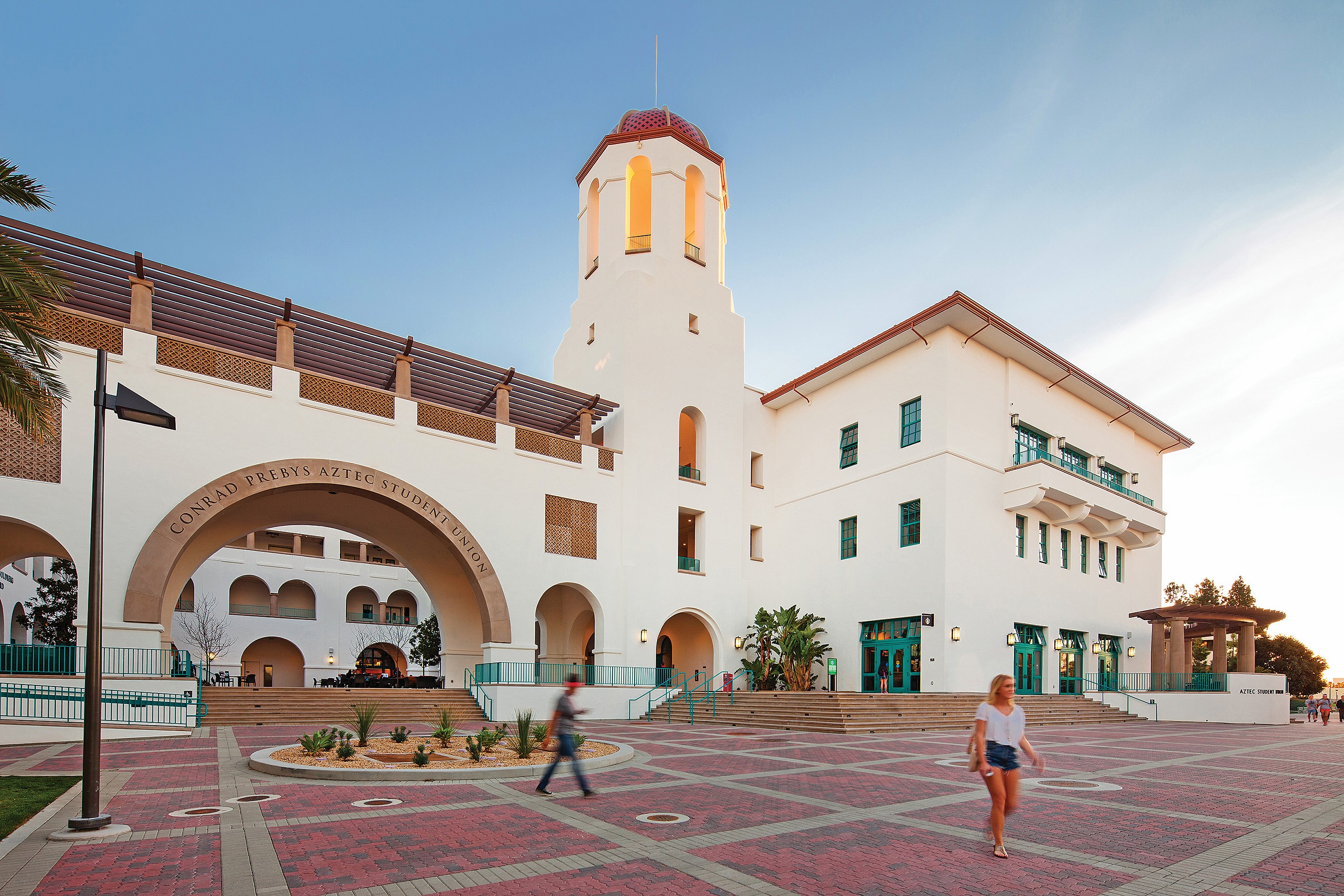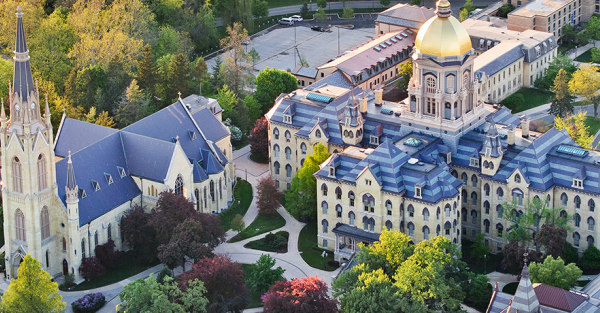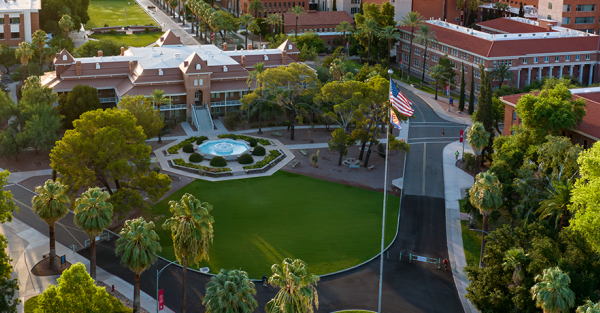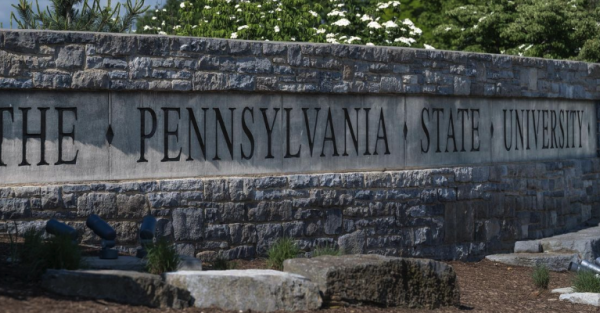San Diego State University
San Diego State University is a comprehensive public research university in California serving more than 38,000 students, including approximately 2,200 international students from over 100 countries. Located near the U.S.-Mexico border, the university leverages its strategic geographic position to provide accessible international opportunities through cross-border research and academic engagement. Through sustained partnerships, innovative programming, and a commitment to access and quality, it has built an extensive internationalization model that serves students both at home and around the world.
San Diego State University (SDSU) was among the first recipients of the NAFSA Senator Paul Simon Award for Campus Internationalization in 2003. Now, more than two decades later, the university has earned the distinction again—not by resting on past achievements, but by continuously redefining what comprehensive internationalization means in practice.
Under the leadership of President Adela de la Torre, SDSU has embraced what de la Torre calls “education diplomacy”—the belief that education transcends borders to create meaningful connections, foster cultural exchange, and address global challenges. It’s an approach that extends far beyond traditional study abroad to encompass cross-border research, community partnerships, and innovative programs that make global experiences accessible to all students.
This commitment is evident in everything from transborder graduation ceremonies in Tijuana to teacher training programs in the Pacific Island nation of Palau and reflects a comprehensive strategy that has evolved alongside the changing landscape of international education.
Building on Legacy
The foundation of SDSU’s internationalization was built by leaders like Ronald F. Moffatt, who directed the International Student Center from 1984 to 2008 and served as NAFSA president in 2007. However, Moffatt’s influence extended far beyond campus—he inspired many professionals still working in the field today, says Noah Hansen, senior director of international affairs.
In continuing Moffatt's legacy, after she became president in 2018, de la Torre elevated internationalization as a central pillar of the university’s strategic plan, emphasizing education diplomacy and transborder engagement.
A key structural change came in 2019 with the creation of the international affairs unit under Associate Vice President and Senior International Officer Cristina Alfaro. This new unit brought together previously scattered functions—study abroad, international student services, and faculty-led programs—under one umbrella reporting directly to the provost. The centralized model also helped bring all colleges on board, building campus-wide support for internationalization.
“By bringing these units together, we are able to deliver a cohesive set of programs aimed at preparing students with the skills and perspectives for successful global careers,” Alfaro says.
SDSU’s “education diplomacy” is operationalized through an expansive global strategic plan built on four key priorities: international access, diversity, equity, and inclusion; global and transborder engagement; international environmental, social, and financial sustainability; and international innovation.
The university has created robust structures to ensure faculty engagement across all disciplines. The International Affairs Senate Council, formed in 2020, brings together representatives from all university colleges to recommend policies, identify resources, and assess internationalization needs. The council annually reports on internationalization progress, and its members serve as ambassadors for international initiatives across campus.
Complementing this governance structure, SDSU launched the Faculty Global Engagement Symposium and Awards Ceremony in 2021, held annually during International Education Week. The event recognizes outstanding faculty in six categories: global research and creative activity, global educator, transborder research and creative activity, transborder educator, global service, and international scholar.
Redefining Study Abroad
In addition to creating the unified international affairs department in 2019, SDSU made a strategic decision that transformed its approach to study abroad: shift focus away from numbers and toward quality, access, and safety. “When you focus on those areas, some people [might] think the numbers [would] go down,” Hansen says. “But . . . we’ve got many more students participating in global learning than we ever have before.”
The strategy worked. During the spring semester of 2025, 640 students studied abroad—an increase of 40 percent compared to pre-pandemic spring semester levels.
An example of this new approach is a collaboration between SDSU students and a peace studies program at Javeriana University in Colombia. The students meet with former Revolutionary Armed Forces of Colombia (FARC) members, government officials, and Indigenous Colombian communities to understand post-conflict reconciliation. In another program in Panama, engineering students examine construction projects at the Panama Canal Zone, combining technical learning with global perspective.
The university also created an international safety, security, and risk assistant director position—the only one in the California State University (CSU) system—to review all international programs, partners, and travel for health and safety concerns.
SDSU addresses access barriers through comprehensive support including annually offering over $400,000 in education abroad scholarships funded by associated student fees and parent workshops. For students unable to travel, the university offers 12 Collaborative Online International Learning programs across 10 partner universities—75 percent focused on Latin American institutions—and domestic intercultural experiences working with local Native American and Arabic communities.
To complement this focus on quality and safety, SDSU developed Global Learning Outcomes in 2021 through a collaborative process that brought together faculty, staff, and students from across the university’s colleges, says Chris Kjonaas, assistant director of global education. These outcomes now provide a structured framework for evaluating partners and programs, helping the university make consistent decisions about international opportunities while ensuring students gain coherent global learning experiences throughout their entire SDSU experience. The framework also enables faculty to designate global learning courses that require at least 15 hours of global learning experience, further integrating international perspectives across the curriculum.
Innovating Across the Border
SDSU’s geographic proximity to Mexico helps foster innovative cross-border programming. The university serves a substantial number of transborder students who live in Tijuana and commute daily to San Diego for classes, creating a truly binational student experience that shapes the campus culture.
This reality inspired unique initiatives like transborder graduation ceremonies, now in their third year. The program emerged after students told Alfaro their parents could not see them graduate because they couldn’t cross the border. What began as an email asking graduating seniors if they’d attend a ceremony in Tijuana has become a major celebration, with hundreds of students and their families participating.
The annual RE:BORDER Conference, now in its seventh year, brings together academics, business leaders, and government officials from both sides of the border to address critical transborder issues. Mexican higher education institutions regularly participate alongside U.S. partners. The conference has grown from 300 to over 800 participants and focuses on topics from water sharing and migration to sustainability and innovation.
Beyond dialogue, the conference generates concrete outcomes—engineering teams from SDSU and Instituto Tecnológico de Tijuana received a $5,000 seed grant in 2023 that led to a six-figure grant from the San Diego Foundation for developing water treatment technologies. The follow-on grant enabled labs at both institutions to develop standardized procedures for water pollution testing, allowing samples to be analyzed on both sides of the border without crossing borders.
Celebrating the linguistic assets of its diverse student body, SDSU’s University Seal of Biliteracy and Cultural Competence (USBCC) allows students to earn digital badges by demonstrating proficiency across four language domains. Launched in 2021 and initially offered in Spanish, the program now includes 50 languages and has engaged 356 students. Other CSU campuses have expressed interest in USBCC, with Alfaro writing a handbook on how to replicate the model.
Expanding Local Capacity Through Sustained Partnerships
SDSU’s connections with Mexico extend far beyond the immediate border region to include deep partnerships in Oaxaca, where the university operates a research center and global health internship program. There, students work alongside local healthcare professionals in primary care, maternal and infant care, and preventive medicine—gaining firsthand experience impossible to replicate on campus. Students also provide public health outreach and logistical support to understaffed clinics. The partnerships also bring economic benefits to the local community through students’ use of host families, transportation, and local services. Over two dozen SDSU faculty conduct ongoing research across disciplines including public health, Indigenous languages, migrant youth, and community development.
This model of sustained, mutually beneficial partnerships is utilized worldwide. In the Republic of Georgia, SDSU has graduated over 520 STEM professionals since 2014 while providing its own faculty with international teaching and research opportunities. The partnership has strengthened SDSU’s engineering and science programs through faculty exchanges and collaborative projects, with SDSU training over 120 Georgian faculty and administrators. The program allows Georgian universities to offer accredited STEM degrees and bolster the country’s tech workforce.
Another partnership focuses on teacher education. SDSU’s partnership with Palau Community College has certified more than 250 local educators while giving SDSU faculty unique insights into Pacific Islander educational systems and Small Island Developing States challenges. The program provides SDSU education students with distinctive field experiences, resulting in 28 of 30 Palau-based students in the most recent cohort successfully completing degrees.
Supporting International Students
Back in San Diego, the International Student Center (ISC) serves as a “home away from home” for approximately 2,200 international students from 100 countries each semester—including those participating in university-sponsored work experience or academic training. The center’s staff, with lived experiences from 21 countries, provides comprehensive support through academic, employment, and immigration advisory services.
SDSU restructured its international student support through a coordinated care advising model and college liaison approach. Each college has a dedicated adviser from the ISC who works directly with faculty and staff to build awareness of international students’ needs.
Our passion drives us to continuously improve our successful global learning opportunities. —President Adela de la Torre
The university established two groups to enhance international student support. The first is the International Student Advisory Board, comprised of international students who provide feedback on campus climate. The second is the International Student Support Workgroup, made up of faculty and staff who work to improve policies and processes based on the students’ input. Feedback from these groups has led to concrete changes, such as revising student success surveys to better reflect international students’ educational backgrounds. During the COVID-19 pandemic, the groups helped SDSU secure separate funding for international students who were ineligible for federal grants and established a supplemental grocery assistance program for international and undocumented students.
A Prominent Place in the Future
The university’s commitment to internationalization is evident in its ongoing investments and expansion plans. SDSU is currently constructing a new $10+ million international affairs building at the campus entrance that is expected to open in 2027. It will bring all international operations—currently spread across multiple locations—together under one roof in a highly visible location that reflects internationalization as a major priority for the institution.
Having achieved R1 research status in early 2025, SDSU is positioned to further expand its global research collaborations and partnerships. The university continues developing the Cali-Baja Higher Education Consortium, which SDSU helped found and where Alfaro serves on the advisory board, as a network of institutions on both sides of the border that aims to enhance student mobility and academic collaboration across the region. Future partnership opportunities also include potential collaborations with institutions in Taiwan, Turkey, and other strategic regions.
“Our passion drives us to continuously improve our successful global learning opportunities,” de la Torre says. “We continue to enrich our institution [in order] to respond to the ever-evolving needs of this interconnected world.”
Lessons Learned
Restructure Education Abroad Advising According to Academic Discipline Rather Than Destination.
SDSU transformed its study abroad model from “where do you want to go?” to “what’s your major?” by assigning international affairs advisers to specific colleges rather than to countries or regions of the world. Each adviser now specializes in one of eight colleges, understanding degree requirements and career pathways. “It’s so seamless that the student doesn’t even know they’re working with someone from a different office,” says Chris Kjonaas, assistant director of global education. This model increases study abroad participation in traditionally difficult majors like STEM while ensuring students graduate on time, as advisers can pre-approve courses and articulate academic credit before students depart.
Engage International Students as Cultural Ambassadors in the Classroom to Support Global Learning.
SDSU’s Global Perspective Symposium provides a structured, no-cost program for faculty to bring international student panelists into their classrooms. Faculty apply through a semester-based process, specifying course topics and desired cultural perspectives. International students receive preparation for serving as cultural ambassadors. This allows faculty to “bring in real people” rather than just reading about cultures in textbooks, says Associate Vice President for International Affairs Cristina Alfaro.







